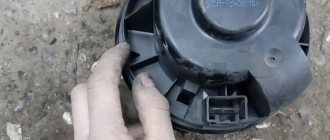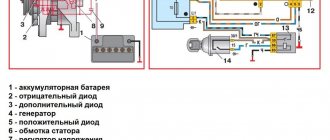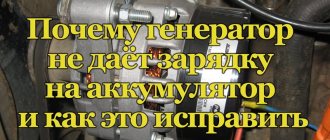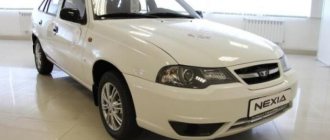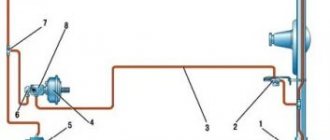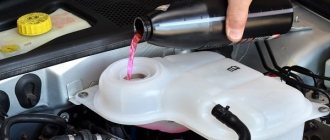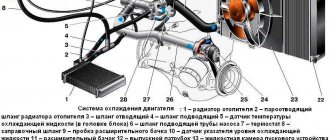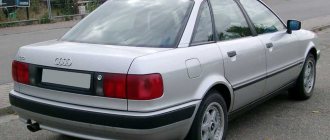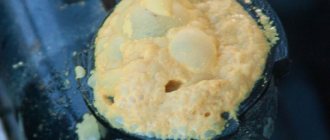A careful and reasonable driver cannot help but be bothered by vibration when braking at high speed. In this case, the car may even partially lose control, its behavior makes you nervous and suspect the worst, and this beating effect is extremely annoying. Moreover, it is quite difficult to notice vibration in the early stages: while driving, some shaking (especially on our roads) is present in any case, and a slight beat is perceived as natural.
However, if vibration nevertheless attracts your attention, you need to look for its causes quickly: this will prevent possible large-scale troubles in the future with the chassis or braking system (and maybe with the steering).
In order not to examine all the components of the car, you need to listen more closely, determine at what stage the shaking appears, and track its dynamics. Vibration can be observed at idle, or when accelerating, or only when the car is braking. All special cases have different root causes, and knowledge of the subtleties will greatly help in diagnosing the problem.
Vibration when braking at high speed is most common in car driving practice, and can be caused by several factors, which we will discuss in our article today.
Where does steering wheel wobble come from?
Steering wheel beating at the moment of braking means spontaneous jerking of the steering wheel in different directions.
In especially advanced cases, the vibration is so strong that the driver has to literally catch the car on the road. At speeds above 50 km/h, the phenomenon creates a real danger for vehicle passengers. Since the steering wheel is rigidly connected to the front wheel hubs through a rack and ball ends, the source of the problem must be sought in the chassis and braking system of the car. The main causes of strong vibration lie in various defects of the brake disc:
- the working part of the product is deformed and has a wavy surface;
- due to the impact, the disk was damaged and cracked;
- The spare part was originally defective or installed incorrectly.
It is no coincidence that the front brake discs are named as the culprits. As soon as the working surface of the part changes its shape a little or gets a defect, after the pads are activated, the front wheels will begin to wobble, repeating the rotation of the uneven element. The steering wheel hits even harder when braking at high speed, as the speed of the front wheels increases.
How a wave-like deformation appears on a disk:
- As the car moves, the elements are repeatedly captured by the pads and can become very hot.
- The temperature is distributed unevenly over the surface; accordingly, the metal in different parts of the part expands more or less.
- If, at the moment of maximum heating, the wheel falls into a puddle or snow, the metal cools sharply and retains its concave shape.
- The brake pads grip the disc and force the wheel to follow the path of rotation of the deformed surface. This is why the steering wheel shakes when braking.
Steering wheel runout also appears after the element is incorrectly fastened or in the presence of a manufacturing defect, when the surface of the spare part is initially curved.
Why does the wheel bounce when braking?
1. It hits the steering wheel or pedals because the brake disc is deformed.
The brake disc is the element to which the wheel is attached. It rotates with it. When braking, when the driver presses the brake pedal, the disc is clamped by two pads and stops. Along with it, the wheel stops rotating.
Since the brake disc provides the braking process, its deformation is the first reason why the wheel hits when braking at speed. How can a disc become deformed? Very simple. The rotor consists of metal, its parameters depend on the machine model. When the brakes are applied, the pads exert enormous pressure on the moving disc, resulting in a large friction force. The rotor heats up, and the increase in temperature leads to a change in the density of the element, after which it needs to cool - evenly over the entire surface. But this does not always happen, and if for some reason the disk cools down sharply, in some places it takes on a wave-like shape, in other words, it becomes deformed. Therefore, in the future, when the pads clamp the dented rotor during braking, it is this that causes vibrations of the entire brake system and the wheels from side to side. The beating is felt in the steering wheel, pedals and throughout the car as a whole.
The cause of sudden uneven cooling of the disc may be falling into snow or a puddle after prolonged braking.
In such situations, it is customary to say that the disk has slipped. If the reason that the wheel hits when braking really lies in a deformed rotor, then another symptom that occurs after overheating of this part is the acquisition of a bluish tint.
It is not difficult to identify a deformed disc if you have such a suspicion. It is necessary to lift the problem wheel on a jack so that it rotates freely. If it makes full revolutions at the same speed without changing trajectory, then everything is in order. If the wheel rotates normally for part of its trajectory, and then slows down or stops altogether, it means that the brake disc is deformed. To decide whether to look for the culprit on the front or rear wheels, you need to brake using the handbrake. If the vibration continues, then the problem is in the rear brake discs.
When a disc is deformed on one of the front wheels, it hits mainly the steering wheel, you will feel it immediately. While the wobble in the rear wheels may not be noticeable, although if the brake disc has moved too much, at high speed you will feel the wheel bouncing when braking. Vibration in the pedal does not specifically indicate where to look for the cause, and you will have to check all the options.
To fix the problem, you need to find the cause of the deformation. This is not always the case for sudden cooling of a disk heated to high temperatures. There is also a problem - the pads jam, and they remain pressed against the rotor during movement, causing a large friction force and strong heating of the disc, and therefore its deformation. In this situation, you need to solve the problem with the caliper, and then fix the damaged rotor.
A warped brake disc can be replaced. Prices for it depend on the brand of car, the range is from 2 to 15 thousand rubles. Not the cheapest pleasure, it should be noted. Another option is boring. This procedure is carried out by a car mechanic at a service station without removing the disc from the car. Its essence lies in boring out wave-like deformations to a flat surface.
In drum brake systems, where the role of the disc is played by the drums, there is an undoubted advantage - they are practically not susceptible to deformation due to overheating or unexpectedly sharp cooling.
2. The wheel hits when braking after replacing the brake disc, hub or wheel bearing.
After a car service where the chassis was repaired, did you feel that the wheel was hitting when braking? Go back and look for the reason. Most often, this problem occurs after changing the brake disc, hub or wheel bearing. Most likely, you were supplied with defective parts. If the parts are in order, it means they were installed incorrectly - perhaps the disk was tightened incorrectly, too tightly or, conversely, too loosely. The pattern for installing the brake disc is indicated on the disc itself.
Naturally, you need to file a claim with the mechanic who carried out repair work on your car, after which you felt that the wheel was hitting when braking.
3. The wheel is bouncing due to a cracked brake disc or drum.
One of the reasons why a wheel hits when braking is a cracked disc or drum in the brake system. This happens extremely rarely, due to high pressure or overheating, but too strong. And then, only heavily worn and rusted parts can crack or break as a result, and, fortunately, conscientious drivers, for the most part, do not let this happen and replace unusable spare parts in a timely manner.
4. Possible reason - pads?
Faulty or poor quality pads are often potential culprits that cause a wheel to hit when braking a car. But we have some doubts about this. Since this spare part is not responsible for the driving force of the car and does not participate in any way in it, it is unlikely that its malfunction can cause vibrations of such force that they can be felt in the steering wheel or pedals.
5. The caliper is working, but the wheel still hits when braking.
Have you checked your brake caliper but found no problem with it? So we need to continue the search. What actions should you take:
- Inspect the front suspension arms. Avoid loosening and deformation of parts due to load.
- Inspect the hub bearing; if it is worn enough, replacement is required.
- Quite often, the reason that the rear or front wheels hit when braking is weak bolts. Check all fastening connections in the body, caliper, suspension, etc. Tighten the bolts tightly and check them regularly.
The following problems are much less common:
- Problems in the steering rack.
- Severe wear of the balls in the chassis.
- Problems with shock absorbers. In this case, the car’s vibrations are noticeable when cornering, and in the direction opposite to where the worn shock absorber is located. Old shock absorber struts may also be the cause.
- Accidents involving impacts on the side, collisions with obstacles (curbs, poles, trees), often result in deformation of the brake rotor.
- Worn tie rod ends.
We recommend
“What do the letters on car tires mean: decoding of all indices” Read more
How to determine the cause
Before drawing any conclusions regarding why the steering wheel shakes when braking, you need to carefully examine all the components of the units. Perhaps the reason is more than clear. And you can make an approximate repair estimate yourself.
If the steering wheel shakes when braking, first of all we check the brake drums, discs and pads.
The disk must have a perfectly round, smooth surface. If they are deformed, “went in waves”, “bumps” have formed or are extremely worn out, it is worth considering why. The car owner could save on quality components and bought a fake from an unknown manufacturer. A very hot disk could get into a puddle or snow. Strong temperature changes are detrimental to metals. Or the driver applied emergency braking, and at that moment the pads left grooves or bent the disc. Previously overheated metal can be easily identified by its bluish tint.
The brake drum must also be perfectly round. It is worth considering that it is still more difficult to deform than a disk.
The pads must be intact and unworn. Check the condition of these mechanisms regularly.
How to check if the brake pedal is beating?
To do this, you need to go to a dry, uniform surface. Of course, it is best if it is asphalt. To complete the picture, you need to disable ABS. If this is not possible, then try to drive in such a way that the system practically does not interfere with the braking process.
Then they accelerate to 80 km/h. They try to brake sharply without the wheels being locked. If the brake pedal hits when braking, then you should think about diagnostics and repair. If there are large vibrations on the steering wheel while reducing speed, it is necessary to reduce the pressure on the pedal and stop the car smoothly.
Brake system elements
Most often it hits the steering wheel when braking due to problems with the system of the same name. And this can happen due to:
- DEFORMATION OF BRAKE DISCS. This is one of the most common reasons. As a result of friction with the pads, the brake disc heats up quite strongly during braking, and if it is cooled sharply (for example, water from a puddle immediately gets on it), it warps (its geometric shape is disrupted). The curvature of the working surfaces of the disc leads to runout in the pads, which is transmitted to the caliper, and from it, in turn, to the hub and steering rods. But warping of the rear brake discs or drums will turn into strong vibration of the body. The problem can be fixed either by grooving the brake discs (a method that allows work to be done without removing the element from the car) or by replacement;
- UNEVEN WEAR OF THE PADS AND THEIR DAMAGE. In this case, the runout will be caused by the uneven surface of the friction linings. Since the pads are worn in to the working surfaces of the brake discs, when replacing or turning the latter, they must be changed;
- WEDDING THE CALIPER. Often the caliper guides become stuck in their mounting holes. Because of this, the caliper will press the pads unevenly when braking and the driver will feel a beating in the steering wheel. Everything can be “cured” by disassembling the unit, cleaning and lubricating its guides and their seats.
Note that problems with the braking system often manifest themselves not only in the steering wheel, but also in the brake pedal.
Also, in the case of a jammed caliper, the car may brake unevenly (jerky).
Knowing additional symptoms can significantly narrow down the search for the causes of the malfunction.
Other reasons
They should be considered last, since they are the result of undetected problems with the ramps - if this concerns the chassis. However, problems with the brakes may also arise. Their diagnosis is carried out as soon as you have determined that the wheels have not failed you.
- Long-term driving with unbalanced wheels inevitably leads to damage to the wheel bearing, and in some cases, to other components that make up the suspension (steering rod, ball joint, etc.);
- Deformation of the brake disc or drum - depending on what type of brake your car has. Geometry distortions can be caused, firstly, by natural wear, secondly, by overheating due to prolonged braking, and thirdly, by a combination of the latter factor with water getting on the hot metal.
How to detect wear on brake discs?
Before repairing, it is necessary to diagnose the breakdown.
Is it just the steering wheel that vibrates? The likely cause is wear of the front brake discs or the system as a whole. Has the brake pedal also changed its behavior? Pay attention to the rear braking system. The handbrake can be used to determine the malfunction. If the vibration stops when using it, then you should look for a problem in the front brake system. Is there any beat left? Examine the technical condition of the rear brake discs and the system as a whole. The procedure allows you to determine the location of deformed parts.
Next, you should test the wheels or study the appearance of the brake discs. Raise the car on a jack and remove it from gear. If the rear axle is suspected, then the handbrake must be lowered. Spin the wheel. Is the rotation uneven and changing intensity in the same place? The problem has been identified. If the test result is negative, move on to the next wheel.
The appearance of the brake disc says a lot about its technical condition. Noticed cracks, unevenness or chips? Replacement or grooving is required, depending on the situation. The presence of a bluish tint on the surface is a sign of overheating.
When inspecting, pay attention to the brake calipers. It's unlikely, but they can also cause vibrations in the steering wheel.
How to determine wear of the chassis and other breakdowns?
Is the failure at the front, but the tested discs are in perfect condition? A visual inspection of the chassis system allows you to find a breakdown. Tie rods and ends are likely causes of steering wheel wobble.
It will be difficult for an inexperienced person to notice the deformation of the structure. But if you notice unnatural bends, then the reason for the vibrations becomes clear. In less severe cases, it is necessary to rely on inspection and evaluation of the system as a whole.
A herniated or deformed tire is easily detected visually even by an inexperienced driver. There shouldn't be any problems with this. If there is no visible damage, it will be useful to remove the wheel and examine the surface from the inside.
Checking the steering mechanism
The car will need to be raised using a jack. The first thing you will need to pay attention to is the tie rod ends. There should be no gaps. Check the play of the rod - you need to grab it and pull it. Your assistant should hold the steering wheel firmly at this time.
Carefully inspect the steering rack - wear may be one of the reasons why the steering wheel shakes when braking at high speed.
The hub as the cause of vibrations during braking
This is a very rare reason, but it should not be ruled out either. Often, the hub is deformed only in an accident or during extremely strong impacts. However, if the car falls into a hole, the wheel is more likely to come off, or vibration will occur in the steering wheel simply when driving. It would be a good idea to check the wheel bearing. If wear is observed, then this is the main reason for the appearance of beats. To diagnose, you should jack up the car (hang the wheel) and check its play - shake it from side to side. The backlash should be minimal, and rotations should be without sounds or hum.
Elimination of vibrations
Eliminating the problem after it has been identified, and not vice versa, is the main task. Then, depending on your means and capabilities, either repair it yourself or turn to professionals. Now, having heard a knock in the steering wheel on bumps and at speeds, or when braking, the steering wheel hits, you already understand the reason for the phenomenon. What to do with damaged parts:
A bent cardan or drive elements on the front wheels can only be replaced. Silent blocks must only be replaced.
Don’t forget to check the upper balls along with the lower ones. Of course, the lower ones bear more load, but the upper ones also fail gradually.
I recommend not agreeing to repair or replace broken suspension parts - reconditioned (refurbished), especially when the factory does not provide for such repairs. Aren't you tired of living? I definitely don't.
They usually try to adjust the steering mechanism, since it has special bolts for adjustment. Yes, and the fasteners sometimes become loose due to vibration, and if adjustment is impossible, they are replaced.
Discs and drums are ground if the thickness of the metal allows, otherwise they are also replaced.
No one will straighten the pads, only change them, and replacing all the pads at once, or on two parallel wheels, replacing one at a time does not solve the problem. The new pad is not worn out, the others have already worn out to some extent, and when braking we get what we were struggling with. A visual video on the topic : Wheel alignment should be checked at every TO-1, and tire balancing is recommended after 5 thousand mileage, even if your steering wheel does not knock. Timely completion of maintenance, which is prescribed by manufacturers and is required in the car manual, helps to find a fault in a timely manner, without waiting for the steering wheel to begin to vibrate and the car to lose control.
The brake hits when the braking system is working properly
If the braking system has been checked, but defective elements cannot be detected, the problem may be hidden in less obvious reasons. In such situations it is recommended:
- Make sure the wheels are properly balanced. An experienced driver can easily determine that the wheels of a car are unbalanced. A clear symptom of this is the rolling of the entire body when the car is moving, and not just the beating of the brake.
- Check the front suspension arms for bending and secure fastenings.
- Check the condition of the wheel bearing. If it becomes excessively worn, it will need to be replaced.
- Make sure that the fastening of body elements, suspension, and braking system is secure. Often the cause of brake chatter is poor bolt tightening throughout the vehicle. This problem is especially relevant when driving on bad roads. Check the tightness of all accessible bolts on the vehicle.
Should you pay attention to the runout if it does not interfere with your ride?
In the event of steering vibration or its transmission throughout the entire body of the car, it would be safer not to bring the situation to a critical level, but to contact a specialist. As a rule, the problem does not require a solution as quickly as possible - you can drive with it for months (and sometimes years). On the other hand, it should be remembered that if the nuts are not tightened properly, the behavior of the brake disc may be unpredictable, which affects driving safety. At the same time, the beating also loads the parts of the chassis system: shock absorbers, steering, parts of the hub - and in the event of a breakdown, all these elements (as well as their replacement) will not be cheap.
In addition to the above, we note that beating at high speed is very dangerous - strong vibration can lead to loss of control of the car, and, as a result, to an accident. Driving in itself is already a source of increased danger for the driver and others. In this regard, it is better not to skimp on eliminating the causes of vibration.
By the way, many motorists don’t even realize how ridiculous they look from the outside with a vibrating steering wheel; remember this when you drive your family or just give a ride to a fellow traveler - from the outside, a shaking steering wheel looks very noticeable.
Is it possible to drive if you feel the wheel beating?
In principle, you can ignore this problem for a long time, but it is important to understand the danger and possible consequences. If the wheel hits when braking, and the vibration radiates into the steering wheel, this is dangerous. In addition, if you brake at high speed, it is difficult to maneuver in this position even in a smoothly running car, and if you cannot hold the vibrating steering wheel in your hands, then a very dangerous situation on the road is created. In addition to self-preservation, it is worth eliminating problems that cause steering wheel vibrations, at least for aesthetic reasons. You understand, it looks quite ridiculous when a driver, while braking, tries to hold a shaking steering wheel in his hands, and at the same time shakes himself.
Danger of resulting vibrations
It's fair to say that slight vibrations during braking often don't lead to any immediate problems. Usually they can continue to manifest themselves with the same intensity for several months, even years.
In case of light vibrations, in order to extend the life of the car and not have to deal with repairs, be sure to exclude any maneuvers that require emergency braking.
If you do not brake sharply, pressing the brake pedal to the floor, there is a good chance of avoiding expensive repairs in the next 1-2 years. It all depends on the specific circumstances.
But at the same time, when vibrations continue for a long time, they have a negative impact on the braking system, chassis and suspension. As a result, the service life of these components is reduced, which subsequently results in expensive and complex repairs.
By not making repairs when slight vibrations occur that become noticeable in the steering wheel, in the short term you can save some money on diagnostics and repairs. But if we talk about long-term prospects, then there is no question of any savings. By postponing a visit to a car service center, you gradually increase the amount of money that you will have to invest in restoring a car worn out by vibrations.
As soon as you feel a strong and sharp blow to the steering wheel, pressing the brake again, some unit has almost failed, and during the next braking it may fail completely. It is strongly not recommended to delay until such a situation arises. This is already a matter of your safety and life, since a breakdown while the car is moving can result in a serious accident with all the ensuing consequences.
Rear brake pads, what condition are they in?
Typically, drum brakes are mounted on the rear wheels of VAZ cars, which have one drawback - a high risk of accumulation of moisture, dust and dirt inside the drum.
As a result, brake pads can stick, break down, or undergo rapid wear. As a result, the brake pedal begins to beat.
The way out of the situation is to completely replace the brake pads on both wheels (on one axle).
Prevention
In order not to understand the causes of steering wheel vibration, the best option would be timely diagnosis and prevention of the chassis and brakes. Sometimes you don’t even need to use the services of car services; some problems can be identified visually using certain signs. For example, if the brake disc has acquired a bluish color, this indicates that it is subject to constant overheating and in this case it is necessary to look for the cause. The same applies to the appearance of waves on the surface.
Try to visit a tire shop regularly so that the balancing of all wheels is constantly rechecked. If this is not done, the vibration can be quite strong, moreover, such an omission can lead to even bigger problems and then repair work will cost an order of magnitude higher. Also, if the tires wear out, it is necessary to replace them in order to prevent problems in other components, which can lead to the steering wheel wobbling.
Typical reasons
This system in cars has a fairly simple structure. There are not many components in it that could fail and cause vibrations. Moreover, every detail can be the source of a problem.
Thus, discs, drums, air getting into the lines, worn calipers and hubs can cause shaking. Sometimes the cause is worn tires. Often a crooked wheel can transmit vibration to the steering wheel, but there will be no vibration to the brake pedal.
conclusions
Any breakdown of a vehicle requires urgent and high-quality repairs. It is important to understand that all parts, especially in the chassis system, are subject to very significant and constant loads. If you refuse repair work, you may face huge financial costs in the future. In addition, this may affect the safety of the vehicle. Steering wheel vibration also has a detrimental effect on the ease of driving the car.
Sources
- https://autochainik.ru/bienie-rulya-pri-tormozhenii.html
- https://www.syl.ru/article/207313/new_bet-rul-pri-tormojenii-na-bolshoy-skorosti
- https://AutoTopik.ru/diagnostika-neispravnostei/1289-bet-rul-pri-tormozhenii.html
- https://AvtoNov.com/%D0%B2%D0%B8%D0%B1%D1%80%D0%B0%D1%86%D0%B8%D1%8F-%D1%80%D1%83% D0%BB%D1%8F-%D0%BF%D1%80%D0%B8-%D1%82%D0%BE%D1%80%D0%BC%D0%BE%D0%B6%D0%B5% D0%BD%D0%B8%D0%B8/
- https://howcarworks.ru/%D0%B2%D0%BE%D0%BF%D1%80%D0%BE%D1%81/%D0%B2%D0%B8%D0%B1%D1%80% D0%B0%D1%86%D0%B8%D1%8F-%D0%B8%D0%BB%D0%B8-%D0%B1%D1%8C%D1%91%D1%82-%D1%80 %D1%83%D0%BB%D1%8C-%D0%BF%D1%80%D0%B8-%D1%82%D0%BE%D1%80%D0%BC%D0%BE%D0%B6 %D0%B5%D0%BD%D0%B8%D0%B8-%D0%B2-%D1%87%D1%91%D0%BC-%D0%BC%D0%BE%D0%B3%D1% 83%D1%82-%D0%B1%D1%8B%D1%82%D1%8C-%D0%BF%D1%80%D0%B8%D1%87%D0%B8%D0%BD%D1% 8B
- https://mojcar.ru/ustrojstva-avtomobilya/podveska-i-rulevoe/pri-tormozhenii-bet-v-rul.html
- https://olade.ru/tryaska-rulya-vo-vremya-tormozheniya-simptomy-i-ustranenie
- https://DriverTip.ru/repair/pri-tormozhenii-poyavlyaetsya-bienie-rulya.html
- https://uremont.com/publications/articles/bienie-rulya-pri-tormozhenii
- https://auto-gl.ru/4-osnovnye-prichiny-bieniya-i-vibracii-rulya-pri-tormozhenii-i-2-sposoba-ih-ustraneniya/
Troubleshooting Methods
Now let's move on directly to the description of repair work that can be used to fix the problem when the car brakes jerkily at low and/or high speeds. We list the methods in the same order as the reasons. So:
- Airing the system . In this case, it is necessary to pump it, remove the air and add the required amount of new brake fluid. You will find the relevant information in the material, which describes how to properly bleed the brake system of a car.
- Warped brake disc . There are two possible options here. The first is that if the thickness of the disk is large enough, then you can try to grind it on a special machine. To do this, seek help from a service station or car service center. However, not all services perform such work. You can contact a familiar turner. The second option is more rational and safe. It consists of completely replacing the disk if its deformation is significant and/or the disk is already worn out and quite thin. In this case, it is better not to take risks and make an appropriate replacement. And you need to change discs (drums) in pairs (left and right at the same time). Checking the disk yourself only makes sense if the disk is severely damaged. Therefore, it is better to carry out inspections, and even more so repairs, at a specialized service station.
- Incorrect installation of disks . To correct the situation, you must remove and install the disk/disks exactly in accordance with the instructions.
- Drum curvature . There are two ways out here. The first is to give it to a turner for boring. The second is their replacement. Depends on the degree of wear and curved geometry of the drums. But it is better to install new nodes.
- Worn pads . In this case, everything is very simple - you need to replace them with new ones. The main thing is to choose them correctly. And the replacement procedure can be performed independently (if you have experience and understanding of such work) or in a car service center.
- Pad sticking . It is necessary to carry out repair work on the lift to restore the functionality of the pads and calipers. It is best to replace the used pads with new, good quality ones to prevent similar situations from occurring in the future.
- The calipers are loose . Repair in this case is impossible. It is necessary to replace the calipers, pins, and, if necessary, pads. When reassembling all components, do not forget to lubricate everything thoroughly with caliper and guide grease.
- Inconsistency between the softness of discs and pads . When choosing these and other nodes, you need to pay attention to the corresponding stiffness value. If necessary, replace some or other parts.
- Large play in wheel bearings . Here, most likely, you will have to replace the corresponding components. You can try to repair them, however, as practice shows, such an idea is ineffective.
- Rust on the brake disc . If the rust deposit is small, then you can do nothing, but operate the car for 500.1000 kilometers until the rust is naturally removed under the influence of the brake pads. Another option is to groove the discs. In fact, the second option is preferable, but more expensive.
- Damaged silent blocks . It is necessary to inspect the mentioned components and, if necessary, replace them.
Read also: If a person drinks alcohol every day
It is noteworthy that in most cases, identifying the cause must be carried out not in a garage, but at a service station using appropriate equipment. After all, “by eye” it is impossible to feel the slightest deviations from the norm, which in fact, at high speed, can be sources of vibrations and other unpleasant phenomena, which not only can cause discomfort for the driver and passengers, but also cause an emergency situation on the roads .
If you have encountered reasons for a situation where the car brakes jerkily that were not listed, we will be glad to hear your thoughts and experience on this matter in the comments under this material.
Good evening. People, who came across this? 2114 8kl. 2009 The car shakes fatally when braking, the front and rear pads are new, the support bearings are also new (More precisely, if you pick up speed from a standstill at a fast pace to 160-180 while driving, it goes smoothly, they don’t hit anything, everything is smooth, if you drive about 110-140 at the same pace, after 100-200 meters, the steering wheel shakes. You press the brake - everything is narrower, the whole car shakes and vibrates impossibly, and up to a speed of 80 km. After 80 km, braking occurs smoothly, and sometimes a small vibration is present, but only sometimes. Has anyone encountered this? Question from : Ilez Yalharoev. The car shakes when braking.
Similar articles
16 comments on “The car shakes when braking. The car shakes fatally when braking"
Driven brake discs
Look at the balance of the wheels, the condition of the brake discs, the caliper may be jamming (look at the guides), it may even be caused by the brake drums and rear beam. There are a hundred reasons, don’t drive too hard
If you buy new ones, you might end up with the same ones you have now. They got me.
Try to loosen the nut on the CV joints a little on both sides and by hand and tighten it with less force than when tightening the wheels. Well, provided that the discs are in good condition. And as a rule, they will be visible even at 20 km/h. Most likely the wheel bearings are overheating.
Read also: How to dilute Heptral for intramuscular administration
It’s like this for you now, you got up in the morning, started it and drove off, everything is fine, it doesn’t shake, accelerated to 120, pressed the brake, it doesn’t shake, drove a little more and the vibration starts, the harder you press, the stronger it vibrates, right? At 2115 the situation was completely identical to yours.
I heard the guy's right CV joint was bent, according to the description it was the same thing, not a grenade, but the axle shaft itself
Is there any shuddering when you gradually pick up speed? If yes, then check the axle shafts for play.
First, hang up the front wheels, wobble each wheel in a horizontal and vertical position and at the same time look at the steering tips and at the connection points of the rod that comes from the steering rack, perhaps the steering tips are broken or the steering rod silent blocks, I did this, if there is no play, then move on brake discs look
180km.h. suicide on the pelvis
Change the internal grenades, I had the same thing on the top ten until I installed new ones.
My drum was burst. The inner cast iron strip is intact, but a little eggy. But a crack in the aluminum jacket was visible from the outside.
Don’t listen to the internal grenades; they vibrate when accelerating, not braking.
Check the crabs, or rather the linings, the nuts may be broken
Grenades vibrate both when accelerating and when braking
Rafis, I don’t know about 180, but 170 175 drives normally and behaves on the road, if the chassis and steering are intact
I had about the same crack, everything even changed the rack until I replaced the pads on the front again with new ones, but the oregina stopped
The safety of the driver and passengers depends on the technical condition of the car. Minor structural damage that causes vibrations in the steering wheel when braking can lead to serious consequences. In most cases, the driver diagnoses the breakdown on his own or goes to a car service center.
The most likely cause of vibration is the condition of the brake discs. But this is not always the case. The culprit may be deformation of the steering racks or the formation of a hernia on one of the wheels.
